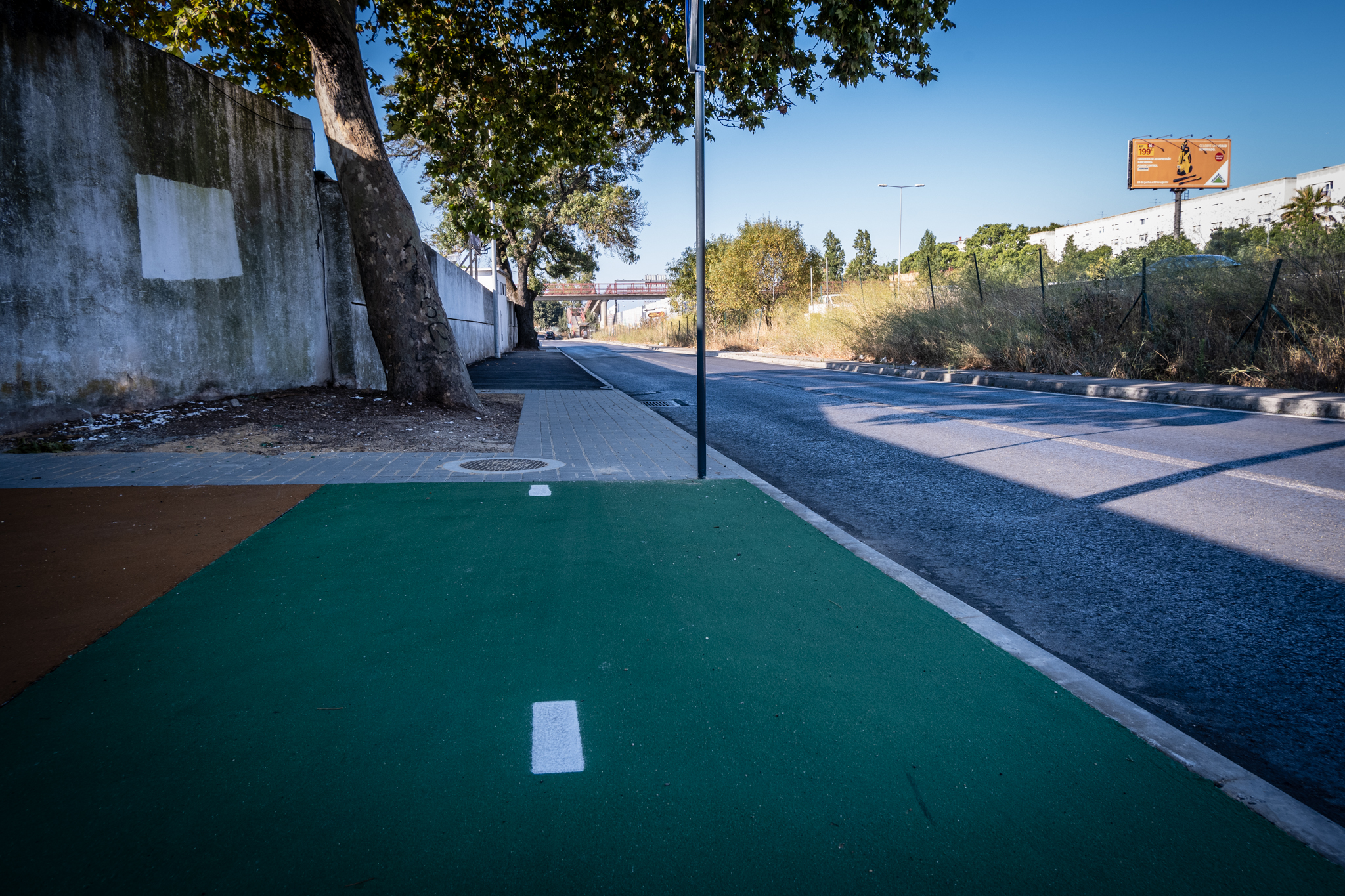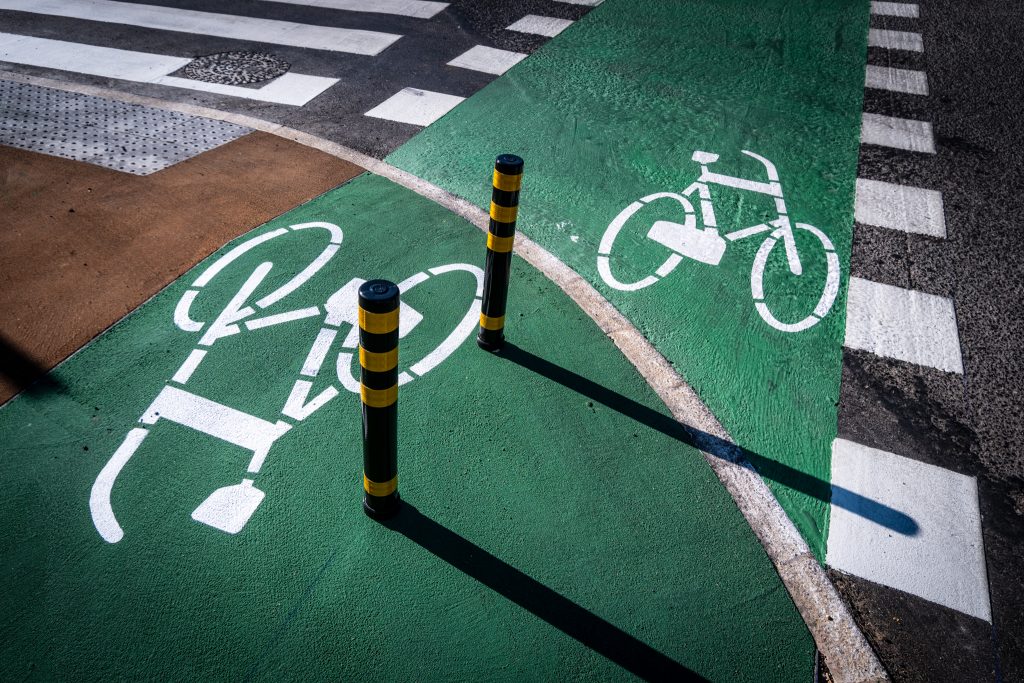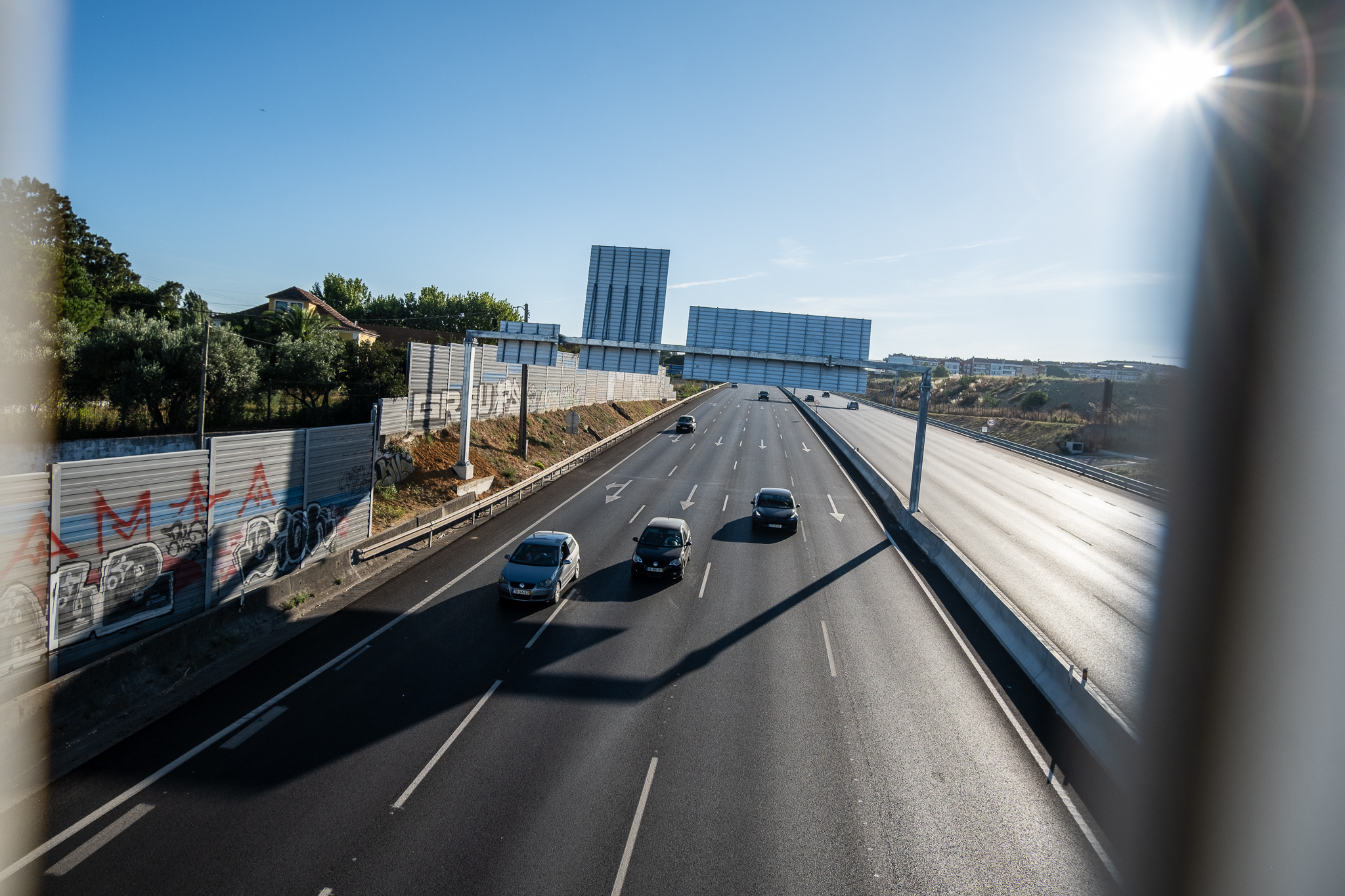
It became known as "Campsite cycle path" (because it connects directly to the Lisbon Camping Park, located in Monsanto), although it is more than thatis the extension of the cycle path from the Benfica Radialis a good shortcut to Belem (just before the Campsite, you cut through to a forest road with no traffic), and will be in the future a bicycle gateway to the city from Amadora or Oeiras.
The Camping Park's cycle path, which is around 2 km long, began to be built in September last year and should have been completed by the end of Juneaccording to the first deadlines. It's not ready yet due to an unforeseen problem on a small section, but it's already passable (a temporary solution was adopted on that section). It's a good cycle path overall, although it has a few avoidable mistakes.
The signs on the bike path
The cycle path ends at the Lisbon Camping Park, on the edge of the municipality of Lisbon, following the Circunvalação Road from the Pina Manique traffic circle (where the cycle path from the Benfica Radial ends) to very close to the CRIL access.
Let's start our analysis with the final section. In addition to the Camping Park, the cycle path serves an IBIS hotel, and it is precisely in front of these two facilities that you will find one of the worst parts of this cycle path, whose design contradicts not only the Traffic Signaling Regulations, but also the Lisbon City Council's own Public Space Manual.
Two vertical signs, one for the cycle path and the other for crosswalks, have been placed on top of one of the traffic directions on the cycle path. While in practical terms there won't be any problems because there won't be a flow of cyclists preventing a temporary detour into the opposite direction, this error is unacceptable from a theoretical point of view: after all, a user of a cycle path has just as much right to have their way unobstructed as a user of a road.
According to the Traffic Signs Regulations in force, the signs "must be placed in such a way as to guarantee (...) the normal movement and safety of users". The Public Space Manual adds that the signs, "despite having heights of more than 0.90 m"The "a safe distance" at least 0.30 m from the cycle path.
The section in question presents another problem related to obstacles. Access to the cycle path, after an existing cycle crossing, forces cyclists to pass two rubber bollards and then encounter one of the two signs placed in the middle of the road. If with a conventional bicycle the cyclist will have to be vigilant but will be able to dodge these practically contiguous obstacles, this may be more complicated with a wider bicycle or a cargo bike - a type of vehicle whose use has been growing in Lisbon.
Another problem with this stretch of road is the lack of a buffer between the cycle path and the road, but only a stone kerb that can be seen separating any sidewalk. The Public Space Manual recommends that on roads where the stipulated maximum speed is 50 km/h, as is the case here, the the width of the protective strip should be at least 0.50 m, while the recommended width is 0.70 m. This is not the case on this cycle path.
This situation applies not only to this section but also to others on the cycle path, where the infrastructure also runs right next to the road. Without the protective strip, a cyclist who becomes unbalanced could fall straight into the traffic. On the section in front of the Ibis and the Camping Park, placing a protective strip, decorated, for example, with shrubs as is the case on Avenida da República, could be an easy solution, given that the road there is one-way and its width could therefore be slightly reduced.
Finally, we have to look at the walkway leading to the Ibison one side of the road, and camping and parking on the other. The cycle path has not been lowered in the crosswalk area, making it impossible for people with reduced mobility to use it, with a baby carriage or a heavy suitcase, for example, and going against all good practices. As an alternative to lowering the cycle path in the area of the crosswalk, a raised crosswalk could have been implemented, while increasing the safety of the area. Also in the square in front of the campsite, the new crosswalk has not been lowered, unlike the one next to it.

The missing section
It is already possible to cycle on the Parque de Campismo cycle path, although one section, near the Bairro da Boavista Municipal Swimming Pool, has not yet been completed. An unforeseen event forced the municipality to find an alternative solutionThis is because the originally planned route would have constrained any maintenance work on an existing underground collector. Until the work progresses, users can use two makeshift crossings and share the road with other vehicles for a few short meters.
The cycle path could not be placed on top of the water collector, as was the case in the initial design, as this would risk making it impossible to carry out the maintenance that is planned for this equipment in the future. Another solution was studied which, at the same time, preserves the tree corridor, does not condition the functioning of the entire built section and creates a segregated channel from the car. So instead of the cycle path going over the road, it will go down a small ramp at the back of the swimming pool building. There will be a small area for pedestrians to share and then a new ramp that will give access to the cycle path again.

Lisbon City Hall expects the construction of the alternative proposal to be completed soonBut until then, users will be able to continue using the temporary solution - which will be preserved in the final intervention. This way, cyclists will be able to choose between taking the shared road or the ramp. The two cycle crossings will be signposted with the appropriate vertical signs and the sidewalk will be repainted to indicate to drivers that there may be a greater presence of cyclists on that small stretch.

For the rest: a good cycle path but, as always, it has compromises
The Parque de Campismo cycle path is a good and necessary link overall, which extends an existing cycle path very close to the limits of the municipality of LisbonIt is a cycle path that connects the isolated Boavista neighborhood to the city, allowing cyclists to access the Camping Park. It's a cycle path that will also allow access not only to Belém via Benfica and Monsanto, but also to the Alfragide industrial area. The work also served to provide the Estrada de Circunvalação with suitable conditions for pedestrian mobility, useful not only for residents but also for public transport users who travel that road.
However, the cycle path does have some imperfections, which we'll point out below:
- the crossings at the Pina Manique traffic circle could have been raised in order to improve safety for bicycle users. This is a high-traffic area, which gives access to the busy Estrada de Monsanto;
- the rubber pins placed at crossings can restrict the mobility of cyclists with wider bikes, such as cargo bikesor, in some situations, wheelchair-bound pedestrians. The pins would not be necessary;
- there is two pedestrian and bicycle sharing zonesOne is due to two trees and the other to an EPAL station. As this is not an area of heavy pedestrian traffic, these areas shouldn't be a problem. However, it should be noted that in order to keep the road at the dimensions indicated by the regulations, the width of the sidewalk and bike lane has been conditioned, contrary to those same regulations;
- a few zig-zags on the bike path that could have been avoided if it weren't for the existing underground collector, which will have to be maintained at some point in the future. By moving the cycle path away from the collector area, the latter will not be constrained in the future.
You can find all the documentation on this cycle path below:
Continuing through Calhariz de Benfica
The Parque de Campismo cycle path will in future be extended from the Pina Manique traffic circle to the heart of Benfica, via the Calhariz de Benfica road. This cycle path is currently out to tender as part of the city's green corridors project. The Calhariz de Benfica road is part of the so-called Peripheral Green Corridor; the western section of this road was intervened in 2020 with the creation of a garden.
The cycle path on Estrada do Calhariz de Benfica will be slimmed down. From two lanes in each direction, it will now have just one; some sections will remain dual carriageway in order to guarantee adequate traffic flow, with emphasis on two BUS zones and areas for exits and entrances onto cross roads. In addition to the bi-directional cycle path that will connect Benfica Station and Rua Carolina Michaelis in the future, Estrada do Calhariz de Benfica will be equipped with sidewalks, a tree-lined corridor and street furniture suitable for passive recreation.
Find out more about what is planned for Estrada do Calhariz de Benfica below:






























